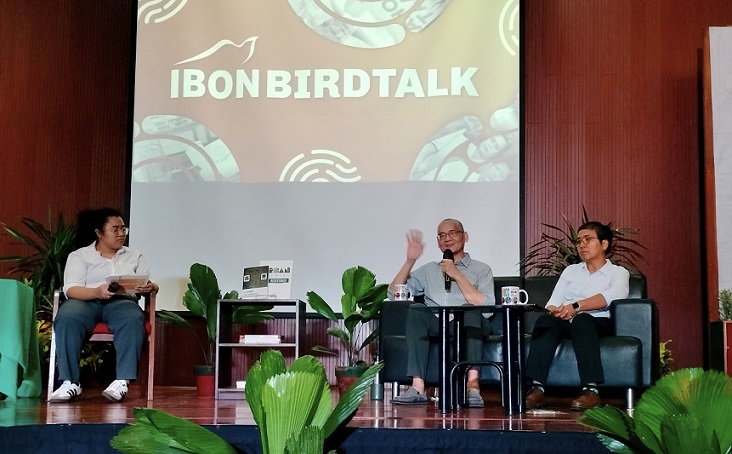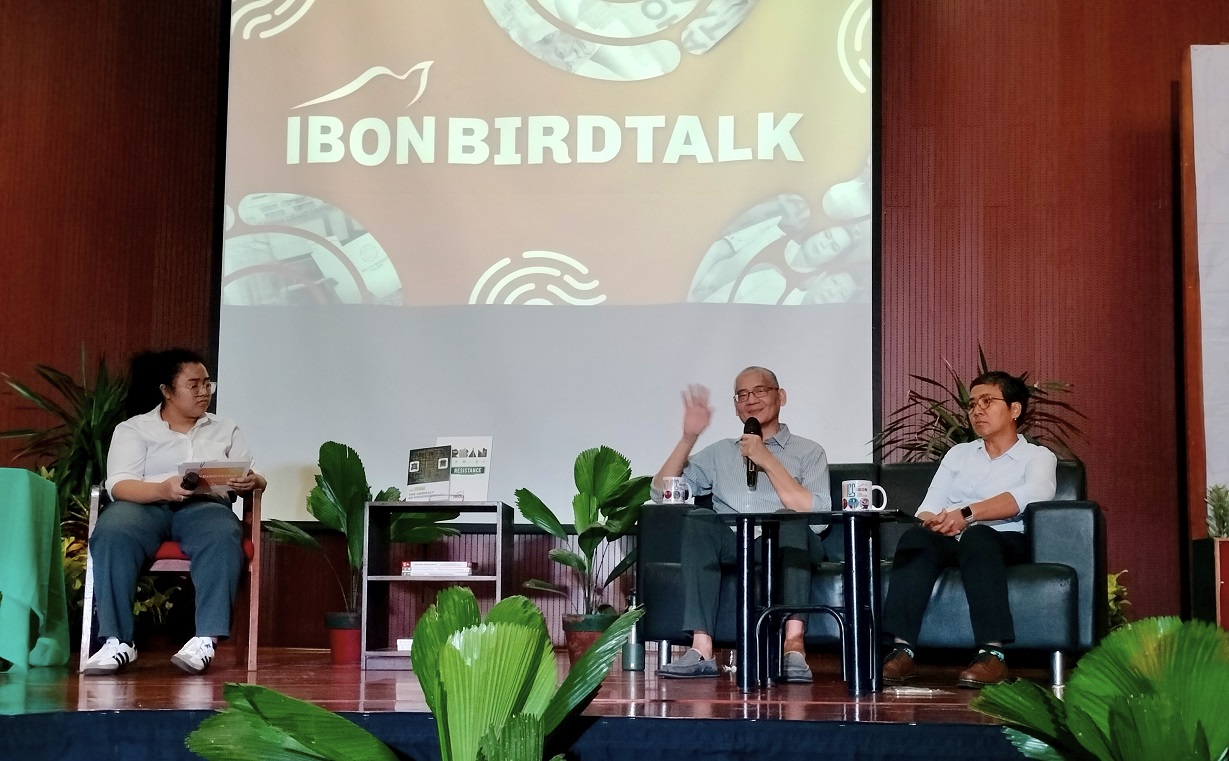Your comprehension didn’t take a nose dive if you couldn’t see the connection between the economic prosperity bruited about by the government and the constant struggle of Filipinos with unemployment. Listening to IBON Year Starter BirdTalk 2025 on Jan. 23 makes you understand why you couldn’t see it.
“It’s not true that the Philippines is developing and is the star of Asia. Things are pretty bad. There’s a great disconnect between government hype and what’s happening on the ground,” Africa, the executive director of IBON, says in his talk at the University of the Philippines Diliman’s Institute of Biology.

Africa is not a social provocateur. He’s not even questioning the figures released by the government; numbers don’t lie, he remarks. The London School of Economics and Political Science graduate is simply making the situation (and numbers) comprehensible for laypeople.
In his presentation “Looking to May 2025 & Beyond: Economic Challenges from the People’s Perspective,” he explains the context of the economic figures while co-speaker Rosario Bella Guzman discusses why national industrialization is the pathway for the Philippines’ economic progress in her presentation “The Urgency of Industrialization.”
Poor nation
The National Economic and Development Authority (Neda) said the Philippine economy remains one of Asia’s fastest-growing economies under President Ferdinand Marcos Jr. The country is in second place with a growth rate of 5.2 percent after Vietnam’s 7.4 percent, moving ahead of Indonesia’s 4.9 percent, China’s 4.6 percent, and Singapore’s 4.1 percent.
Neda Secretary Arsenio Balisacan, citing the Philippine Statistics Authority, said the industry and service sectors performed well, particularly construction, finance and insurance, which saw year-on-year growth rates of 5 percent and 6.3 percent, respectively. Conversely, the agriculture, forestry, and fishing sectors posted a year-on-year decline of 2.8 percent.
Even Africa’s slide on self-rated poverty from 1983 to 2023 depicts growth from 38 percent in 2019 to 57 percent in 2024. However, he argues, the bandied prosperity actually signified growth at a “very low level of development,” with “joblessness getting worse because it’s hidden by labor force statistics.”
Africa acknowledges the prosperity,“rapid growth and increasing GDP per capita, profits, and billionaire wealth,” but points out that the wealth is concentrated within a small group of people.
He expounds: “Prosperity is gushing up. There’s no trickle down. Hunger has grown and the number of poor has increased during Marcos’ term. Poverty and inequality are rooted in economic structures. The service sector is driven by a few economic activities, yet manufacturing is down to the smallest share of the GDP in 75 years and agriculture to the smallest in history.”
His slide on 2023 Global GNI per capita makes clear the Philippines’ impoverished state. The average annual income of Filipinos is only US$5,230 against the global average of US$18,554, putting the country in 150th place in the global ranking of 220 countries. (GNI, or gross national income, measures the total income of a country’s residents.)
“Upper middle income is an illusory measure of progress. The Philippines is still among the poorest countries in the world,” Africa says.
Few jobs
It’s unfathomable that the agriculture sector of an agricultural country like the Philippines is in shambles. The weak agriculture sector has led the Philippines to “food import dependency since 2022,” Africa says, adding that it remains in the pre-Industrial backward era where “agriculture is falling and manufacturing is a diminished productive sector” compared to Japan, South Korea, and Taiwan that flourished under globalization.
Despite the strong performance of the service industry, it has low to zero job creation, he says. His slide shows the businesses with low job creation: power (0.2 percent), water (0.2 percent ), telecom (1.0 percent ), real estate (0.5 percent), health (1.5 percent), finance (1.4 percent), transportation (7.7 percent), and hotel and restaurant (5.1 percent).
Tellingly, the profitable industry companies are owned by the oligarchs (aka economic elites), with the slide of “13 Richest Filipinos” listing the magnates as “Sy, Villar, Razon, Ang, Caktiong, Aboitiz, Gokongwei, Consunji, Ayala, Lucio Tan, Andrew Tan, Co, and Ty.”
Says Africa: “What will the Philippines sell with the decline in manufacturing? Who’s benefiting from the decline? The business elites and dynasties. Who’s invested in the status quo? Political dynasties and traditional politicians.”
Significantly, the economic elite is also the political elite, with dynasties (between 300 and 400 families) dominating the political scene, which poses a problem because “of their bad behavior in keeping the Philippines poor,” he points out. “Their policy remains the same — make the richer richer and the poor poorer. The squabble is for political power among traditional politicians, not how to strengthen the economy of the Philippines.”
Africa’s next slide shows the seats held by the Filipino tycoons’ political parties in “Oligarchic rule.” For example, Enrique Razon’s National Unity Party has 45 seats in the House of Representatives and nine governors; Manuel Villar’s Nationalisa Party has 45 House seats, four senators, and 11 governors; and Ramon Ang’s Nationalist People’s Coalition has 35 House seats, five senators, and 11 governors. Not to forget the Marcos and Duterte families holding varied positions ranging from district representatives to president.
National industrialization is the way for the Philippines to progress and its sovereignty has to be upheld, or “we’ll be in the worse state in the coming decades,” Africa contends.
Building industries
Guzman shores up Africa’s contention, positing that the crisis is structural. She underscores the urgency to reject neoliberalism (which, she says, has been the Philippines’ political approach for the last two decades) and to embrace national industrialization.
Her premise that “a solid economic plan based on agriculture is a chance for the Philippines to reboot its economy” is based on the global context and the country’s current condition. She says the global context is marked by crises heightened by wars and geopolitical tensions, waves of people’s protests, and growing contradictions between the United States and its rivals with the increase in US protectionism. Protectionist policies are implemented by 193 countries, with 5.2 percent coming from the G7 nations (or the world’s advanced economies: Canada, France, Germany, Italy, Japan, the United Kingdom, and the United States).
“For the Philippines that relies on foreign capital, such disruptions create limiting export markets, but this is the moment to reduce on volatile markets, focus on strengthening national industrialization,” says Guzman, who heads IBON’s research department. “It’s wrong to say that a country progresses because of trade. We should ask for manufacturing and neutrality, not alignment. What can the Philippines sell or exchange with other Asean countries?”
To explain the Philippine condition, Guzman borrows a line from Amado Guerrero’s “Philippine Society and Revolution” — “mayaman ang Pilipinas” (the Philippines is rich) — and enumerates the country’s qualities: “vibrant and consistent social movement,” large productive labor force, minerals, territorial waters replete with marine resources, and arable land area.
The labor force, she emphasizes, is crucial in pushing for national industrialization because “the farmers, fisherfolk, youth, intellectuals, and formal and informal workers can champion the policies.” She further says the success of national industrialization requires a strong state that will provide protection, vast authority and resources, and democratic accessibility, that will prioritize ecological sustainability, and that will uphold the workers’ rights and welfare.
However, she adds, national industrialization becomes futile if workers are not provided resources and social services to improve their well-being.
Challenges
Guzman throws the gauntlet at the senatorial candidates in the May elections. She wants to know who among them, apart from those in the Makabayan bloc, will declare national industrialization as the major strategy for Philippine development. Also, which senatorial aspirants will reclaim and assert Philippine economic sovereignty and give Filipino manufacturers immediate relief from decades of suffering under neoliberalism?
Other challenges are laid bare during the Q-and-A portion. The first question is: “How long will the Philippines take to return to the golden age of protectionism?”
Guzman clarifies that the Philippines is in the modern capitalism stage and has never gone through a golden age. Change isn’t measured by years, “but by the strength and determination of the citizens’ movements,” she explains. “China took less than 10 years to reverse its semi-feudal and colonial structures while their cultural revolution took longer.”
Africa says the “golden age” can happen between 20 and 25 years if the President implements industrialization on Jan. 24, or the day after IBON’s presentation.
He elaborates: “South Korea and Taiwan took 20 to 25 years to be in a dynamic industrialized state. China wasn’t industrialized yet, but had high productivity and high income in 2010. It takes time because only a state with discipline and resources can get to an industrialized phase.”
The second question is when prices of commodities will go down amid the skyrocketing inflation. Guzman’s response: It will never happen in monopolies selling inferior products at high prices, gobbling up other industries and getting support from the state.
She adds: “It’s a permanent inflation in the Philippines. It’s not true low inflation means low prices. If we start producing industrial products, we can manage the prices.”
Africa says prices won’t go down this year because of food dependency and variations in the exchange rate of the Philippine peso and the US dollar. It’s “a strong possibility due to the Trump aftershocks and the cut in the agriculture budget,” he says. “You can’t produce cheap food.”
Silver lining
“Bleak” is the first adjective to zip through my mind after IBON’s presentation. The Philippines’ future is inauspicious, with the present prosperity advantageous only to a few while the majority of Filipinos face unemployment. That most Filipinos don’t have savings doesn’t bode well for the situation, says Africa.
“Disposable” is the other. Filipinos have always lived in desperation, leaving families behind for employment abroad and many ending up dead. Will the time ever come for Filipinos to stop playing dice?
Still, the doom and gloom has a silver lining: Africa and Guzman brim with the proverbial hope. Guzman envisions a Philippine economy that produces for and takes care of the needs of its citizens, and upholds national sovereignty.
Africa sees Filipinos playing an important role. “We can’t give up on the government,” he says emphatically. “We must work for a better government. The casualties of globalization and corruption are the people who gave up on the government.”

